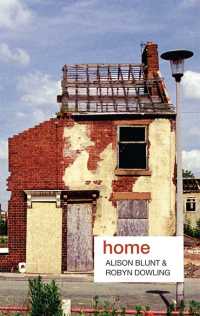Full Description
FACILITATES WRITING SUCCESSFUL PROPOSALS OF SUBSTANCE, CLARITY, AND CONVICTION
With an in-depth focus on writing with substance, clarity, and conviction, this comprehensive resource takes the reader step by step through the entire process of writing and submitting a successful proposal. Written by preeminent authors and educators with extensive experience in teaching proposal and grant writing to nurses and other health care professionals, the book discusses how to create proposals for dissertations, capstone projects, research funding, fellowships, and career development awards, as well as for educational training, translational research, evidence-based practice, and demonstration projects. Using a clear, commonsense approach, it delineates the foundations and underlying structure of a well-written proposal and then focuses on the specific elements required for each different type of proposal.
The book provides readers with the tools to help them think through what they want to do and describe it clearly and succinctlyóavoiding unnecessary information that does not support the intent of their proposal. It discusses selecting a problem, developing an argument, and describing the aims of the project; showing the significance of the problem and describing the conceptualization and innovative aspects of the work; detailing the approach or research design and methods; composing the title and abstract; describing budgetary considerations; and preparing ancillary materials. The book also includes worksheets to help readers personalize the information for their particular project. Instructions on how to synthesize the relevant literature for a study is presented in helpful case examples. The book also addresses the processes of writing and submitting a grant, its review, and possible resubmission. It will be highly useful as a text in master's-level, DNP, and PhD research courses; doctoral seminars, for instructors who advise students on proposal development; and for practitioners who are interested in developing evidence-based practice.
KEY FEATURES:
Provides abundant tools for writing proposals of substance, clarity, and conviction
Takes readers step by step through the process of writing a great variety of proposals
Facilitates clear thinking and to-the-point writing
Includes worksheets to help readers personalize information for their particular project
Provides formats required for all federal grant proposals
About the Authors:
Sandra G. Funk, PhD, FAAN, is a professor emerita of the School of Nursing at the University of North Carolina at Chapel Hill. She has taught research methods, statistics, and grant writing to master's and doctoral students, postdoctoral fellows, visiting scholars, and faculty, and co-teaches with Elizabeth M. Tornquist a program on grant writing. As associate dean for Research and director of the Research Support Center for many years, Dr. Funk led the school's research mission and mentored faculty on design, measurement, proposal development, and research management. She also consults with other universities in these areas. She has served as principal investigator or co-investigator on over $6 million in research funding and served as a reviewer for the National Institutes of Health and other federal agencies for over a decade. Her research interests, grants, and publications, which number over 100, focus on various aspects of applied measurement and research utilization and facilitation.
Elizabeth M. Tornquist, MA, FAAN, has been a faculty member of the Schools of Nursing and Public Health at the University of North Carolina at Chapel Hill and is currently a visiting lecturer at the College of Nursing, University of Arkansas for Medical Sciences. She has taught scientific writing for nearly 40 years and has conducted numerous workshops for university faculty, health care clinicians, and scientists in industry on writing grant proposals, research and technical reports, and articles for publication. She is nationally known as an editor and has helped scientists from many disciplines write fundable grant proposals and publishable articles. In addition, she has authored two books and dozens of articles, and she co-edited three books in addition to those written with Dr. Funk.
Together, Dr. Funk and Ms. Tornquist have taught proposal writing courses and grant-writing institutes; been awarded grants from the National Institutes of Health, the Division of Nursing, and the Agency for Healthcare Research and Quality; developed a research utilization model; published a dozen refereed articles and edited six books (five of which were honored with AJN Book of the Year awards and two of which were republished in other languages).
Contents
CONTENTS
Preface
SECTION I: PREPARING A PROPOSAL
1. Introduction
Your Goals
Funding Trajectories
Finding Funding
Learn About the Funder
Funding Opportunity Announcement (FOA)
Contacting the Agency
Read the Proposal Guidelines
Aids
2. Rationale for the Proposed Work
Conceptualizing the Search
Identifying the Relevant Literature
Deciding What to Read
Reading and Analyzing the Literature
Synthesizing the Literature to Make the Case for Your Study or Project
The Problem
The Work Done on the Problem
Shortcomings in the Work Done to Date
Developing a Conceptual Framework
3. Design and Methods
Basic Methods
Overview
Preliminary Work
Setting(s)
Sample
Intervention
Control or Comparison Group
Variables and Their Measurement
Procedures
Plans for Data Management and Analysis
Wrap Up
SECTION II: TYPES OF PROPOSALS
4. PhD Proposals
The Traditional Approach
Three Different Approaches
The NRSA Proposal
The Traditional Proposal in Two Chapters
A Different Three-Chapter Approach
Developing the Proposal
5. NIH Research Grant Proposals
SF424 (R&R) Application Guidelines
Structure
Required Minutiae
Review Criteria (Briefly)
Writing the NIH Research Application
Introduction
Specific Aims
Research Strategy
Summary
6. Fellowship Proposals
National Research Service Awards
Research Training
Training
Sponsor and Co-Sponsor Information
Additional Educational Information
Letters of Reference
Summary
7. Career Development Award Proposals
National Institutes of Health
Candidate Information
Statements and Letters of Support
Environment and Institutional Commitment
Research
Letters of Reference
Other NIH K Awards
8. Translational Research, Evidence-Based Practice, and Demonstration Project Proposals
Translational Research
Purpose and Structure
Writing the Proposal
Evidence-Based Practice Projects
Purpose and Structure
Writing the Proposal
Demonstration Projects
9. Educational Training Grant Proposals
Introduction
Need
Target Population
Program
Evaluation
Organizational Capacity
Detailed Work Plan
Sustainability and Replicability
Statutory Funding Preference
Meeting the Review Criteria
SECTION III: ADDITIONAL MATERIALS
10. Title and Abstract
Creating a Coherent Title
Titles for Research Proposals
Titles for Educational Training Grant Proposals
Writing an Effective Abstract
Writing the Project Narrative
11. Biographical Information
NIH Biosketch Information
Biosketch for Research Grant Proposals
Biosketch for Career Development (K) Award Proposals
Biosketch for Fellowship Proposals
Biographical Information for Non-NIH Proposals
12. Budget
Introduction
Research Budget
Budget Justification
Modular Budgets
Career Development Award (CDA) Budgets
Fellowship Budgets
Small Research Grant Budgets
Educational Training Project Budgets
Approvals
Review
Conclusion
13. Supplementary Materials
Protection of Human Subjects
Data and Safety Monitoring
Inclusion of Women and Minorities
Planned Enrollment Report
Inclusion of Children
Vertebrate Animals
Select Agent Research
Multiple PI/PD Leadership Plan
Consortium/Contractual Arrangements
Letters of Support
Resource Sharing Plans (or Plans for Dissemination of Model and Findings)
Facilities and Other Resources (Including Equipment)
Bibliography and References Cited
Appendices
For Research, Career Development Award, and Fellowship Proposals
For HRSA Grant Proposals
For Other Proposals
SECTION IV: DEVELOPING, SUBMITTING, AND REVIEWING PROPOSALS: NEXT STEPS
14. Developing the Proposal: Start to Finish
Planning a Timeline for Submission
Publishing Preliminary Work
Developing a Team
Finding Settings
Writing the Proposal
Finding Time to Write
Developing Purpose and Aims
Developing the Rationale for the Study
Writing About Methods
Developing the Budget and Other Materials
Revising the Proposal
Reviews and Further Revisions
15. Submission and Review of the Proposal
Submission
Approvals—Get Them!
Cover Letter
Review
Receipt and Assignment of the Proposal
Informing the Possible Funder
The Review: Who, How, and When?
Waiting for the Feedback
Getting and Surviving the Feedback
16. Next Steps
Analyzing the Reviews of a Proposal
Deciding What to Do Next
Resubmitting the Proposal
Getting Funded or Approved for Implementation
Getting "The Word
"
Doing What You Said You Would Do
Reporting and Publishing
Index








